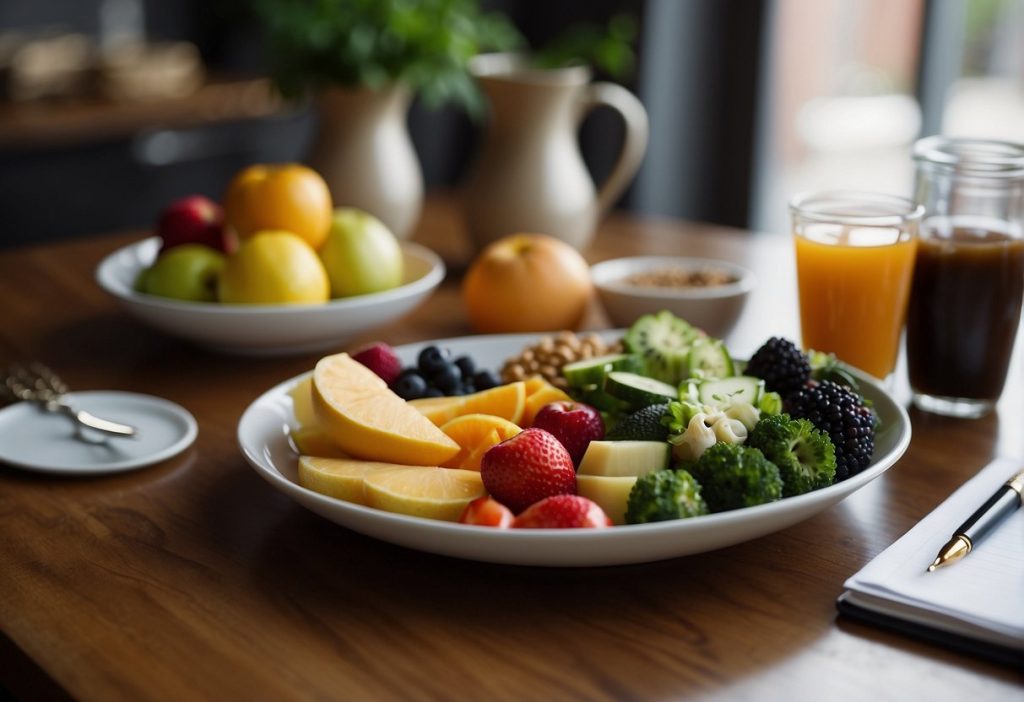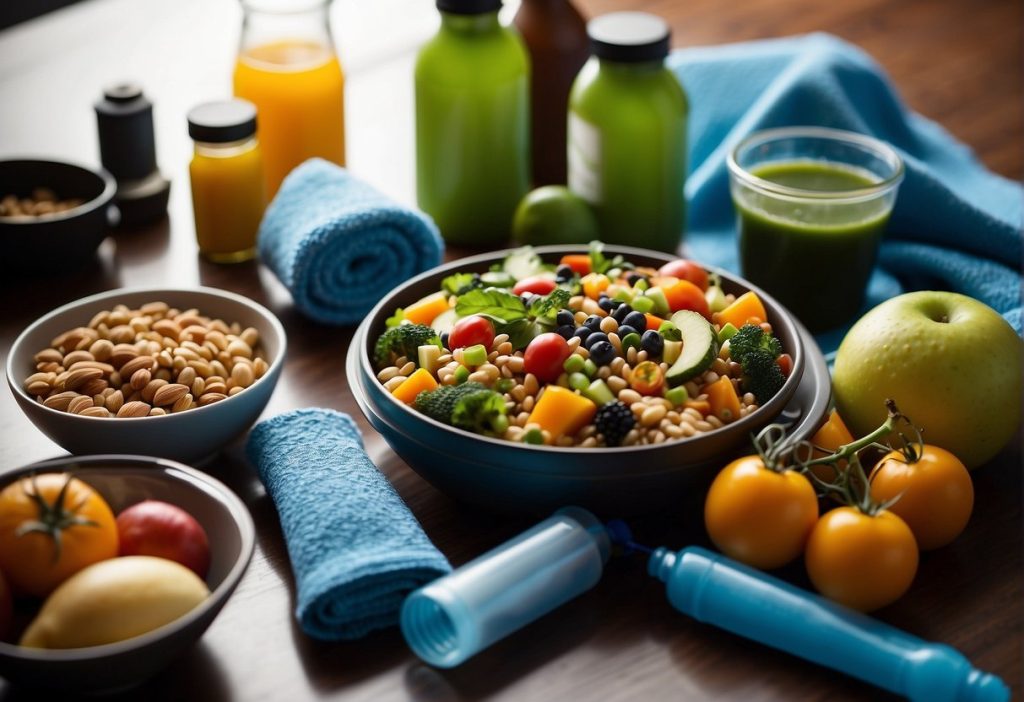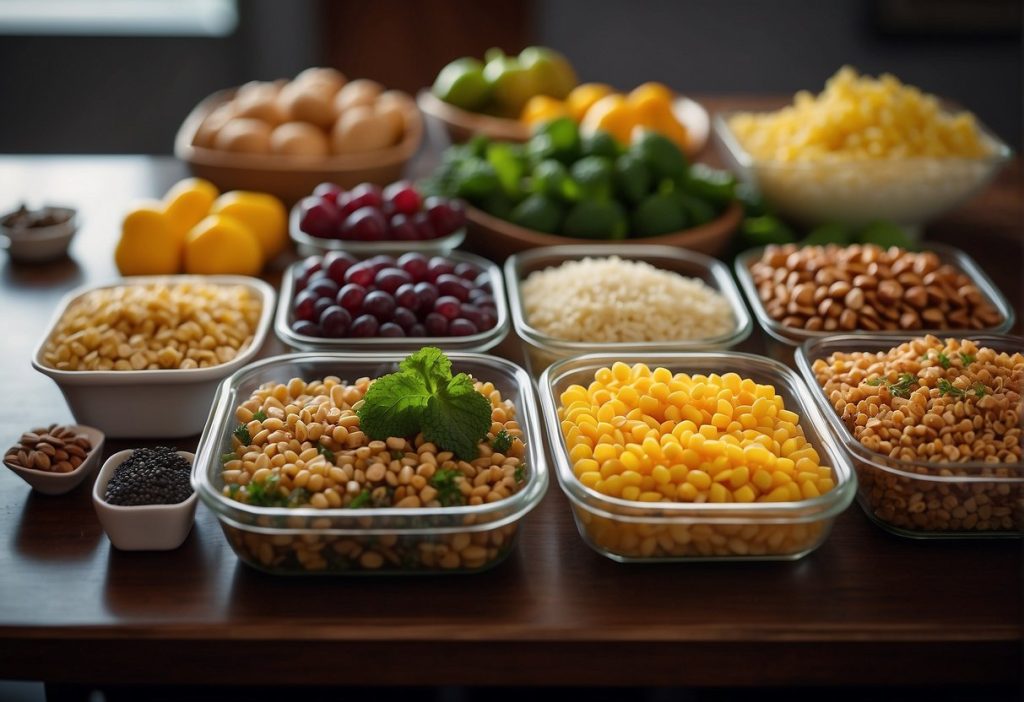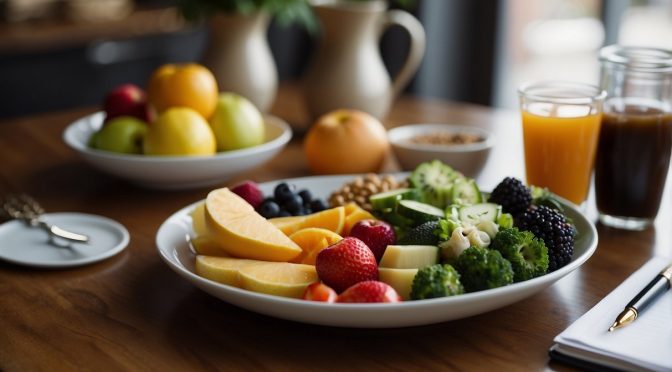Fitness meal planning is not just about the foods you select. It’s also about understanding the role that calories and macronutrients play in your body’s functioning. Determining your daily caloric needs is a critical first step. It guides how much energy you’ll need from your meals to support your fitness activities and lifestyle. Once you’ve established this, a breakdown of proteins, carbohydrates, and fats helps tailor your meal plan to your specific needs. This includes building muscle, losing fat, or maintaining your current physique.

Crafting a grocery list becomes an essential tool in your fitness journey. It steers you toward healthier food choices while shopping. By focusing on whole, unprocessed foods, you can avoid the pitfalls of impulsive, unhealthy purchases. This organized approach to eating translates into a more structured and disciplined routine. It not only fuels your workouts, but also fosters a strong mindset toward health and nutrition.
Key Takeaways
- Planning meals in advance aligns nutritional intake with fitness goals.
- Understanding calorie and macronutrient needs is essential for an effective diet.
- A structured grocery list promotes healthier food choices and dietary habits.
Benefits of Fitness Meal Planning

Proper fitness meal planning can simplify your life. It saves time and money. It also helps manage your calorie intake efficiently, ensures you consume a balanced diet, and accommodates your dietary preferences or restrictions.
Saving Time and Money
By investing time in meal planning, you allocate your resources wisely. Batch cooking or preparing meals in advance can drastically reduce the time spent in the kitchen throughout the week. A well-thought-out meal plan allows you to create a shopping list, eliminating the impulse buys that often lead to overspending. Using a grocery delivery service can save time and potentially money. It reduces the need to make frequent trips to the store.
- Budgeting Benefits:
- Meal Prep: Reduces eating out
- Bulk Purchasing: Lowers cost per serving
- Grocery List: Helps avoid unnecessary purchases
Controlling Calorie Intake
Planning meals ahead of time makes maintaining a calorie goal straightforward. If you’re aiming for weight loss, knowing the calories in your meals helps you stay on track. Using tools like the MyFitnessPal app can assist in tracking your intake and keeping you informed.
- Calorie Management:
- Pre-determined portion sizes prevent overeating
- Apps provide real-time feedback on your daily intake
Ensuring a Balanced Healthy Diet
A balanced healthy diet that includes vegetables, fruits, whole grains, lean proteins, and healthy fats is essential for your body’s nutritional needs. Planning your meals ensures that you’re covering all the nutritional bases and meeting your nutrition goals.
- Diet Composition:
- Fruits & Vegetables: Vital for vitamins and minerals
- Whole Grains: Important for fiber and energy
- Lean Proteins and Healthy Fats: Essential for muscle repair and satiety
Meeting Dietary Restrictions or Preferences
You can customize your meal plan to align with any dietary requirements, such as vegan, vegetarian, gluten-free, keto, or paleo diets. By planning, you can ensure that your meals respect your dietary restrictions and keep you within your nutrition goals.
- Customization:
- Vegan/Vegetarian: Focus on plant-based proteins
- Gluten-Free: Incorporate gluten-free grains
- Keto/Paleo: Adjust for higher protein and fat, lower carbs
Determining Calorie Intake
Understanding your daily calorie requirements is a cornerstone for achieving your weight loss and health goals. It is important when planning a fitness meal.
Understanding Daily Caloric Needs
Your daily caloric needs are primarily determined by your basal metabolic rate (BMR) and your activity level. To establish a clear calorie goal, consider the balance of macronutrients in your diet. These are proteins, fats, and carbohydrates.
- BMR: This is the number of calories per day your body needs at rest to maintain life-sustaining functions. It varies based on age, sex, weight, and height.
To calculate your BMR, you can use the following formulas:
- For men: BMR = 88.362 + (13.397 weight in kg) + (4.799 height in cm) – (5.677 * age in years)
- For women: BMR = 447.593 + (9.247 weight in kg) + (3.098 height in cm) – (4.330 * age in years)
Once you have your BMR, you need to adjust it based on your activity level using the Harris-Benedict Equation:
- Sedentary (little or no exercise): BMR x 1.2
- Lightly active (light exercise/sports 1-3 days/week): BMR x 1.375
- Moderately active (moderate exercise/sports 3-5 days/week): BMR x 1.55
- Very active (hard exercise/sports 6-7 days a week): BMR x 1.725
- Super active (very hard exercise & physical job or 2x training): BMR x 1.9
Your macronutrient intake, particularly protein, affects your health and fitness results. Proteins are vital for muscle repair and growth. They play a critical role, especially if your fitness goal includes building muscle.
An example distribution for macronutrients in a balanced diet might look like this:
- Proteins: 10-35% of total daily calories
- Fats: 20-35% of total daily calories
- Carbohydrates: 45-65% of total daily calories
For weight loss, creating a calorie deficit by consuming fewer calories than your body burns is essential. However, the quality of consumed calories is crucial for maintaining health. This is especially true when pursuing weight loss goals. Prioritize nutrient-dense foods and adequate protein intake. This supports muscle maintenance and overall well-being.
Remember, these calculations serve as a starting point. Adjustments may be necessary as you progress and monitor your body’s response to your diet and activity levels.
Macronutrient Breakdown

In meal planning for fitness, understanding the macronutrients is critical for achieving your health and fitness goals. Proteins, fats, and carbohydrates are the macronutrients.
Determining Optimal Ratios
Tailor your nutrition plan to support your health and fitness objectives. A balance of macronutrients is essential for optimal body function.
- Proteins: Essential for muscle repair and growth, protein should make up a significant part of your diet. Aim for sources like chicken, fish, beans, and legumes.
- Recommended Intake: Approximately 10-35% of your daily calories from protein.
- Fats: Despite misconceptions, healthy fats are crucial for nutrient absorption and joint health. Include sources such as avocados, nuts, and olive oil.
- Recommended Intake: Roughly 20-35% of your daily calories from fat.
- Carbohydrates: You should not neglect your primary energy source, carbohydrates, especially if you’re active. Choose complex carbs like whole grains and vegetables for sustained energy.
- Recommended Intake: About 45-65% of your daily calories from carbs.
To calculate your specific needs, consider your body type, activity level, and fitness goals. Adjust these ratios as your body and goals evolve. Maintaining a balanced diet rich in fiber and nutrients from diverse food sources will promote overall health. Remember, these are starting points, and you should adjust based on your body’s response and the advice of a nutrition professional.
Choosing Healthy Food Options
Smart meal planning is essential for maintaining a healthy lifestyle and achieving fitness goals. Your focus should be on selecting a variety of nutrient-dense foods that cater to your taste preferences. This applies whether you follow a standard, vegetarian, or vegan diet.
Incorporating Nutrient-Dense Foods
Nutrient-dense foods provide substantial amounts of vitamins, minerals, and other nutrients with relatively few calories. These should form the foundation of your balanced diet.
- Fruits and Vegetables: A colorful assortment on your plate ensures a range of essential nutrients.
- Aim for at least 5 servings of fruits and veggies each day.
- Popular options: Apples, berries, carrots, and kale.
- Lean Proteins: Choose proteins that support muscle repair without excess fats.
- Examples: Chicken breast, canned tuna, and salmon.
- Vegetarian sources include legumes such as lentils, beans, and chickpeas.
Emphasizing Whole Grains, Lean Proteins, and Leafy Greens
A balanced diet includes a good mix of whole grains, proteins, and greens. These not only contribute to overall health but can also be delicious when prepared creatively.
- Whole Grains: These are essential for energy and digestion.
- Include options like brown rice, quinoa, and whole-wheat pasta.
- They should make up about a quarter of your plate.
- Proteins: Protein is key for building and repairing tissues.
- Lean meats such as turkey, chicken, and seafood like tuna and salmon are great choices.
- For plant-based diets, look to tofu, tempeh, and legumes.
- Leafy Greens: Rich in vitamins and minerals, they are a must for your healthy meals.
- Insert plenty of spinach, kale, and Swiss chard in salads and sides.
Remember, the key is variety. Choosing whole foods over processed ones will always align with your healthy lifestyle and fitness objectives.
Creating a Grocery List
Before you venture into grocery shopping to stock your pantry, fridge, and freezer with meal planning in mind, it’s essential to create a structured grocery list. This ensures that you get all the necessary ingredients while minimizing impulse buys.
Preparation Steps:
- Refer to your meal plan for the week.
- Check your pantry, fridge, and freezer for what you already have.
Creating Your List:
- Organize your shopping list by categories (e.g., Produce, Dairy, Meats) to streamline your shopping trip.
- Be specific about quantities (e.g., 2 lbs of chicken breast) to align with your meal plan.
Example Grocery List:
| Produce | Dairy | Meats |
|---|---|---|
| Spinach (1 bag) | Greek yogurt (1) | Chicken breast (2 lbs) |
| Tomatoes (5) | Cheddar cheese (8 oz) | Lean beef (1 lb) |
| Avocados (3) | Eggs (12) | Salmon fillets (4) |
Remember, the goal is to purchase what will fulfill your planned meals and avoid wasting food. Stick to your grocery list to maintain discipline and ensure a successful meal plan execution.
Fitness Meal Planning: Frequently Asked Questions
Q: How do I create a fitness meal plan?
A: Creating a fitness meal plan involves a few key steps:
1. Set your goals: Determine whether you want to lose weight, build muscle, or improve overall health. Your meal plan will vary based on your specific fitness goals.
2. Calculate your calorie needs. You can use an online calculator or consult with a nutritionist. Determine your daily calorie needs based on your activity level and goals.
3. Choose nutrient-dense foods. Include a variety of lean proteins, whole grains, healthy fats, and plenty of fruits and vegetables in your meal plan.
4. Plan your meals and snacks. Aim for a balance of macronutrients (protein, carbohydrates, and fats) in each to support your fitness goals.
5. Consider portion sizes. Pay attention to them to avoid overeating and ensure you’re consuming the right amount of calories for your goals.
6. Stay consistent: Stick to your meal plan as much as possible. Also, allow for flexibility and occasional treats to maintain a healthy relationship with food.
Follow these steps. Be mindful of your fitness goals. Create a personalized meal plan that supports your health and wellness.
Q: What is a good meal plan for working out?
A: A good meal plan for working out should provide the energy and nutrients your body needs. It should fuel your workouts, support muscle recovery, and promote overall health. Here’s an example of a balanced meal plan for a day of workouts:
Breakfast:
- Whole grain toast with avocado and poached eggs
- Greek yogurt with berries
- Glass of water or herbal tea
Mid-Morning Snack:
- Apple slices with almond butter
Lunch:
- Grilled chicken breast
- Quinoa salad with mixed vegetables
- Side of steamed broccoli
- Water or unsweetened iced tea
Afternoon Snack (Pre-Workout):
- Whole grain crackers with hummus
- Sliced cucumber and bell pepper
Post-Workout Snack:
- Protein shake with banana and almond milk
Dinner:
- Baked salmon
- Sweet potato
- Mixed green salad with olive oil and balsamic vinegar dressing
- Glass of water or herbal tea
It’s important to adjust portion sizes and meal timing based on your individual needs and workout schedule. Additionally, staying hydrated throughout the day is crucial for optimal performance and recovery. This meal plan provides a good balance of carbohydrates, protein, and healthy fats. It supports your workouts and overall fitness goals.
Q: How do I plan a meal around a workout?
A: Planning a meal around a workout involves timing your meals. You should choose foods that provide the necessary energy and nutrients to support your exercise session. Here’s a general guideline for planning a meal around a workout:
- Pre-Workout Meal:
Aim to eat a balanced meal containing carbohydrates, protein, and a small amount of healthy fats about 2-3 hours before your workout.
Choose easily digestible foods such as whole grains, lean protein, and fruits or vegetables.
Avoid heavy, high-fat meals that may cause discomfort during exercise. - Snack Before Workout (Optional):
If you’re exercising within an hour, consider a small snack. It should be rich in carbohydrates and have a moderate amount of protein. For example, you could eat a banana with a tablespoon of nut butter or a yogurt with some berries. - Post-Workout Meal:
After your workout, eat a meal or snack containing both carbohydrates and protein. This will replenish energy stores and support muscle recovery.
Examples include a protein shake with a banana, a turkey sandwich on whole grain bread, or a bowl of Greek yogurt with granola and fruit.
It’s important to listen to your body. Adjust your meal timing and composition based on your individual preferences. Also, consider your digestive comfort. Staying hydrated before, during, and after your workout is also crucial for optimal performance and recovery.
By planning your meals around your workout, you can ensure that you have the energy and nutrients needed to support your exercise session. This promotes overall fitness and well-being.
Q: How do I plan a diet to lose belly fat?
A: To lose belly fat, plan a diet that creates a calorie deficit by eating fewer calories than you burn. Make nutritious food choices. Here are some general guidelines for planning a diet to lose belly fat:
- Focus on Whole Foods. Base your diet around whole, unprocessed foods such as fruits, vegetables, lean proteins, whole grains, and healthy fats. These foods are rich in nutrients and can help you feel full and satisfied.
- Control Portion Sizes: Be mindful of portion sizes to avoid overeating. Using smaller plates and measuring your portions can help you manage your calorie intake.
- Limit added sugars and refined carbohydrates. Minimize your consumption of sugary beverages, sweets, and refined carbohydrates such as white bread and pastries. These can contribute to belly fat.
- Include Lean Proteins: Incorporate sources of lean protein such as poultry, fish, tofu, legumes, and low-fat dairy into your meals. Protein can help you feel full and support muscle maintenance during weight loss.
- Choose Healthy Fats: Include sources of healthy fats such as avocados, nuts, seeds, and olive oil. These fats can provide satiety and support overall health.
- Prioritize Fiber-Rich Foods. Foods high in fiber, such as fruits, vegetables, whole grains, and legumes, can help you feel full and aid in digestion.
- Stay Hydrated: Drink plenty of water throughout the day to stay hydrated and support overall health.
- Be mindful of overall caloric intake. Specific calorie needs vary from person to person. Creating a moderate calorie deficit can support gradual and sustainable weight loss.
It’s important to note that spot reduction of belly fat through diet alone is not possible. Overall weight loss and fat loss will occur throughout the body. Additionally, regular physical activity supports your efforts to lose belly fat and improve overall body composition. It includes both cardiovascular exercise and strength training.
Before making significant changes to your diet, it’s advisable to consult with a healthcare professional or a registered dietitian. They will help ensure that your dietary plan is safe, effective, and tailored to your individual needs and health status.

